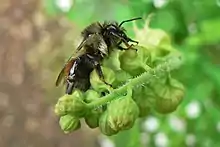Bombus melanopygus
Bombus melanopygus, the black-tailed bumble bee,[2] black tail bumble bee[1] or orange-rumped bumblebee,[3] is a species of bumblebee native to western North America.
| Bombus melanopygus | |
|---|---|
 | |
| Scientific classification | |
| Domain: | Eukaryota |
| Kingdom: | Animalia |
| Phylum: | Arthropoda |
| Class: | Insecta |
| Order: | Hymenoptera |
| Family: | Apidae |
| Genus: | Bombus |
| Species: | B. melanopygus |
| Binomial name | |
| Bombus melanopygus Nylander, 1848 | |
| Synonyms | |
|
Bombus edwardsii | |
This bee is widely distributed across western North America, from the Pacific to the Rocky Mountains, and from Alaska to Baja California.[4][5]
There are two forms of the black-tailed bumblebee:[4]
- Red form (“red butts,” Bombus melanopygus melanopygus) found primarily in higher latitudes of Oregon and points north, and in the Mountain West
- Dark color form (Bombus melanopygus edwardsii) is most common in California and southern Oregon
(The second and third abdominal segments are red in northern populations and black in southern; individuals with black segments were previously known as Bombus edwardsii, a separate species. Genetic analyses support the conclusion that the two forms are the same species, with B. edwardsii as a synonym.[6])
This bumblebee can utilize a number of habitat types, including agricultural and urban areas. It is "one of the few bumblebees still found regularly in San Francisco".[7] It feeds on many types of plants, including manzanitas, Ceanothus, goldenbushes, wild buckwheats, lupines, penstemons, rhododendrons, willows, sages, and clovers. It nests underground or aboveground in structures.[1]
This species is a host to the zombie fly (Apocephalus borealis).[8]
References
- Hatfield, R., et al. 2014. Bombus melanopygus. Archived 2018-08-02 at the Wayback Machine The IUCN Red List of Threatened Species. Downloaded on 04 March 2016.
- Bombus melanopygus. Archived 2014-08-13 at the Wayback Machine Natural History of Orange County, California. School of Biological Sciences, University of California, Irvine.
- Bumblebees: photo gallery. Archived 2016-03-06 at the Wayback Machine E-Fauna BC. Department of Geography, University of British Columbia, Vancouver. Accessed 4 March 2016.
- Koch, Jonathan; Strange, James; Williams, Paul (2012). Bumblebees of the Western United States (PDF). U.S. Forest Service, Pollinator Partnership, Agricultural Research Service. Archived (PDF) from the original on 2022-06-05. Retrieved 2022-06-19.
- "Black-tailed Bumble Bee (Bombus melanopygus)". iNaturalist. Archived from the original on 2022-06-19. Retrieved 2022-06-19.
- Owen, R. E., Whidden, T. L., & Plowright, R. C. (2010). Genetic and morphometric evidence for the conspecific status of the bumble bees, Bombus melanopygus and Bombus edwardsii. Journal of Insect Science, 10(1), 109.
- NatureServe. 2015. Bombus melanopygus. Archived 2018-01-01 at the Wayback Machine NatureServe Explorer 7.1 Accessed 4 March 2016.
- Apocephalus borealis. Archived 2019-12-18 at the Wayback Machine Featured Creatures. University of Florida IFAS. Publication Number EENY-605. October 2014.
